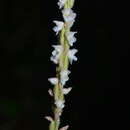en
names in breadcrumbs


Hetaeria, commonly known as hairy jewel orchids,[2] is a genus of about thirty species of flowering plants in the orchid family Orchidaceae. Plants in this genus are terrestrial herbs with a succulent rhizome and a loose rosette of leaves. Small, pale, hairy non-resupinate flowers are borne on a thin, hairy flowering stem. They are found in tropical Africa and Asia to New Guinea, Australia and some Pacific Islands.
Orchids in the genus Hetaeria are terrestrial, perennial, deciduous, sympodial herbs with a creeping, succulent, above-ground rhizome anchored to the ground by wiry roots. The leaves are dark green, usually narrow, thin-textured and arranged in a loose rosette with a short petiole-like base, the lower leaves usually withered by flowering time. The flowers are non-resupinate and usually small, dull-coloured and hairy with the dorsal sepal and petals joined to form a hood over the column. The labellum is glabrous and has a deep pouch near its base.[2][3][4]
The genus Hetaeria was first formally described in 1825 by Carl Ludwig Blume and the description was published in Bijdragen tot de flora van Nederlandsch Indië.[1][5] (Blume gave the name Etaeria, but Hetaeria is a conserved name.) The name Hetaeria is an Ancient Greek word meaning "comrade" or "companion".[6]
Species recognized as of August 2018:[1]
Hetaeria, commonly known as hairy jewel orchids, is a genus of about thirty species of flowering plants in the orchid family Orchidaceae. Plants in this genus are terrestrial herbs with a succulent rhizome and a loose rosette of leaves. Small, pale, hairy non-resupinate flowers are borne on a thin, hairy flowering stem. They are found in tropical Africa and Asia to New Guinea, Australia and some Pacific Islands.